Wismar
![]()
The title of this article is ambiguous. For other meanings, see Wismar (disambiguation).
The Hanseatic city of Wismar is located on the Baltic Sea coast of Mecklenburg-Vorpommern at the southern end of Wismar Bay, which is protected by the island of Poel. It is the sixth largest city and the largest of the 18 medium-sized centres in the state of Mecklenburg-Vorpommern.
Wismar is the county seat of the district of Nordwestmecklenburg as well as the seat of the Wismar University of Applied Sciences. Wismar is a popular tourist destination, especially due to its cultural-historical significance with a valuable townscape and thanks to its location on the Baltic Sea, increasingly also for cruises. Economically important are also the industrial port and shipping industry, for example with the MV shipyards and suppliers, various mechanical engineering companies, wood processing and the solar industry, as well as gastronomy and retail. Since 1881, Wismar has also been home to the headquarters of the Karstadt department store chain.
Wismar was an early member of the Hanseatic League and flourished in the late Middle Ages, which can still be seen today in the townscape through many Gothic architectural monuments. In 2002, the old towns of Wismar and Stralsund were included in the UNESCO World Heritage List as Historic Old Towns of Stralsund and Wismar.
After the Thirty Years' War, Wismar came under Swedish rule in 1648, lasting until 1803 (de jure 1903), which is commemorated by the annual Sweden Festival. After that the city belonged to Mecklenburg-Schwerin. During the Second World War, the city was hit by several bombings, which particularly affected the Gothic Quarter with the main churches of St. Marien and St. Georgen and the Old School. Much has since been rebuilt and renovated in keeping with the preservation order.
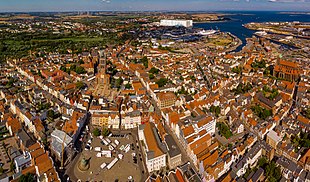
Market, city centre and harbour

View from the old harbour to the old town of Wismar, which together with Stralsund is a UNESCO World Heritage Site.
Geography
The town is located at the southern tip of the Wismar Bay of the same name on the Baltic Sea. Here the Köppernitz stream and the town pit, artificially created in the founding century and fed by the mill pond, flow into the harbour basins to the Baltic Sea. The canal extension, begun in 1577 by the ducal court architect Tilemann Stella, flows east of the old town into the Baltic Sea. It was first called Viechelnsche Fahrt, but it was not until the 19th century that the name Wallensteingraben became established. The canal had to overcome a difference in altitude of 38 metres and proved to be uneconomical and subsequently silted up. Despite this, plans for the canal still exist today, most recently in 2008 through a feasibility study commissioned by the district administration of the Nordwestmecklenburg district. But the necessary funds for the construction and maintenance of the controversial waterway to the Baltic Sea were lacking. There are several smaller and two larger standing waters in the town area, the Mühlenteich and the Viereggenhöfer Teich.
enlarge and show information about the picture
![]()
Panoramic view of the market place (2006) - view from the town hall side
City breakdown
Wismar is divided into eight districts, each of which is subdivided into city districts:
- Old town with the district area Altstadt
- Wismar North with the districts Fischkaten, Redentin, Müggenburg, Eiserne Hand, Schwanzenbusch, Haffeld South and Haffeld North
- Wismar East with the districts Wismar East and Kagenmarkt
- Dargetzow with the districts Dargetzow, Kritzowburg and Groß Flöte
- Wismar South with the districts Wismar South, Kluß and Rothentor
- Friedenshof with the urban districts Friedenshof and Dammhusen
- Wismar West with the districts Burgwall, Weidendamm, Köpernitztal and Lübsche Burg
- Wendorf with the urban districts Wendorf, Hinter Wendorf, Hoben and Insel Walfisch
Climate
The annual precipitation is 599 mm and is thus comparatively low, falling into the lower quarter of the values recorded in Germany. Lower values are recorded at 21 % of the measuring stations of the German Weather Service. The driest month is February, the most precipitation falls in July, twice as much as in February. Precipitation varies little. Lower seasonal variations are recorded at eleven percent of the measuring stations.
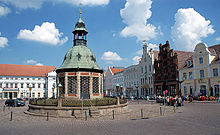
The waterworks Wismar at the market place; on the left behind the town hall, on the right the brick gothic town house (today: Restaurant Alter Schwede) and Reuterhaus
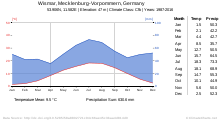
Climate diagram Wismar
History
→ Main article: History of the Hanseatic City of Wismar
Name
Wismar was formerly called Wismaria, Visemêr, Wismar (1147, 1167), Wyssemaria (1229) or Wismaria (1237), among others. The origin of the town's name is not clear, it is said to derive from the name of the stream east of the town, the aqua Wisemaraa.
The presumed settlement of Alt Wismar (document from 1167) may have later been absorbed into the new town.
Since 1990, the city has once again borne the name Hansestadt.
City foundation
The region around Wismar has been settled for thousands of years. After the departure of the Germanic tribes during the migration of peoples, Wendish or Slavic Obodrites lived here until the end of the 12th century.
The foundation of the town, estimated at 1226, probably goes back to the prince Heinrich Borwin I.. The people who settled here - according to their family names - probably came from Holstein, Westphalia, Lower Saxony and the Mark Brandenburg. In 1229 the town of Wismar was first mentioned in a document. Shortly afterwards, the Lübische Stadtrecht was introduced in Wismar and confirmed in 1266. The individual settlements around St. Marien and St. Nikolai grew together until 1238. Due to the influx of settlers, the new town around St. Georgen was added from 1250. In Wismar there were monasteries of the mendicant orders of the Franciscans (since 1251/1252, "Grey Monastery") and Dominicans (since 1292/1293, "Black Monastery"). Prince Johann I of Mecklenburg moved his residence from Mecklenburg Castle to the Weberkamp in front of the city in 1257, and Wismar remained the dukes' residence until 1358. 1267 was the first big city fire, the reconstruction took place with many brick houses. In 1276, the first settlement phase was completed with the erection of a city wall enclosing all quarters, the course of which still forms the boundary of the old town today, and Wismar had reached its expansion, which was valid until the 18th century.
Hansezeit
Wismar became an important member of the Hanseatic League in the Middle Ages. Wismar's Hanseatic period began when envoys from Lübeck and Rostock met in Wismar on 6 September 1259 to conclude a treaty of protection against increasing piracy. In 1280 Wismar, together with Stralsund, Rostock, Lübeck and Hamburg, formed the Wendish League of Cities on the Hanseatic Baltic Sea Route. The Rostock Land Peace that followed in 1283 stabilized the cooperation of the Hanseatic cities.
After an uprising in 1310 against Henrich II of Mecklenburg, Wismar had to submit to the duke in 1311. In 1350 about 2000 inhabitants died of the Black Death. Wismar took part in the warlike conflicts of the Hanseatic League with Denmark with the towns of the Wendish Quarter. After the Peace of Stralsund, Emperor Charles IV visited the city in 1375.
At the beginning of the 15th century, the craftsmen's offices under their leader Claus Jesup revolted and set up a New Council, which, however, could not permanently hold its own against the patriciate and the long-distance merchants. The unrest escalated again in 1427 after the defeat of the Hanseatic fleet, and in Wismar the fleet leader as well as the mayor Johann Bantzkow were executed on the execution block of the market square.
Since the effective levying of taxes for state purposes, the revenue from which came mainly from the trading turnover of urban merchants and the wages of free city dwellers, required the cooperation of the urban financial authorities, the introduction or alteration of each individual tax was subject to the approval of the estates, of which Wismar was one, at their state congresses. Their origin dates back to the beginning of the 14th century, when the knighthood, the totality of the vassals in Mecklenburg, which had been meeting irregularly since the 13th century, called in representatives of the towns, which formed the Landschaft. Since the unification of Mecklenburg under Henry IV in 1471, the estates of the three partial dominions of Mecklenburg (Mecklenburgischer Kreis), Wenden (Wendischer Kreis) and Stargard (Stargardscher Kreis) increasingly gathered for joint provincial assemblies before forming a union in 1523 to counteract the imminent renewed dynastic dismemberment of the land by Albrecht VII.
The Reformation started in Wismar from the Franciscans. The monk of the Grey Monastery Heinrich Never adopted the new Lutheran doctrine at an early stage. The Grey Monastery became a school around 1540 and then a Latin school.
The Viechelner Fahrt canal, today called the Wallensteingraben, was put into operation in 1594 as a waterway to Lake Schwerin and the Elbe, but fell into disrepair again shortly afterwards.
Sweden Time
During the Thirty Years' War, Wismar was occupied by imperial troops in 1627. In 1632 Sweden conquered the city, and the Swedish Crown received Wismar as a German imperial fief in the Peace of Westphalia in 1648 after the end of the Thirty Years' War. From 1653 the city was the seat of the Supreme Tribunal.
In the Schonian War Wismar was conquered by the Danes in 1675 and remained Danish-occupied until November 1680, after which Wismar reverted to Sweden and was developed into one of the strongest naval fortresses under Swedish rule.
See also: Wismar Fortress
In 1711, the Danes were victorious over the Swedes in front of the city in the battle at Lübow. The city fortifications could not be conquered, but were razed after the Swedish defeat in the Nordic War, after the besieged Wismar had been taken by Prussian-Danish troops in 1716 in the Pomeranian campaign of 1715/1716.
Swedish rule over Wismar ended de facto in 1803, when Sweden pledged the city to the Duchy of Mecklenburg-Schwerin for 99 years under the Malmö Pledge Treaty. Formally, Wismar reverted to Germany in 1903 and Sweden renounced the redemption of the pledge. Wismar therefore celebrates the annual Sweden Festival.
From 1803 to 1933
From 1806 Napoleonic troops occupied Mecklenburg and Wismar, in 1813 they left again.
Economically weakened by times of Sweden and occupation, the buildings decayed; shipping, brewing and trade experienced a decline. Wismar's town hall of 1350 collapsed in 1807; a new building was erected in 1819. The import duty remained until 1867, when Mecklenburg joined the North German Confederation.
From 1815 onwards, work began on laying out the Lindengarten. In 1816, the first Mecklenburg music festival took place in Wismar with the performance of Joseph Haydn's oratorio The Creation in St. Nikolai. This developed into the second oldest music society in Germany, founded in 1818. In 1821 the Hammersche bathing ship was inaugurated in Wendorf. This attraction was in operation until 1850. In 1825 the municipal "Ersparniß-Anstalt" (savings institution) started its operation in the town hall. In 1831 the Wismar cemetery was built south of the old town in front of the Mecklenburg Gate. As part of the city wall, it was demolished in 1869 in the course of the defortification of the city. In 1842 the theatre on Mecklenburger Straße was opened. The theatre burned down in 1948.
In 1827, the Hanseatic city applied to be reinstated in the Landschaft, from which Wismar had left under Swedish rule, but initially did not succeed. The first paved road to Schwerin was built in 1834, that to Brüel in 1844, followed by roads to Kröpelin in 1846 and Lübeck in 1847.
In 1862 the first warehouse was built in the harbour and in 1888 the new grand ducal customs office. The Old Harbour from around 1775 was supplemented by the New Harbour until 1893 and by the Wood Harbour and the West Harbour from 1909. In 1927 the sea border slaughterhouse was built. The new granaries, the Löwe granary from 1935, the high Ohlerich granary from 1938 and the Kruse granary from 1940, were intended to stimulate the transport of grain, but handling stagnated. The sea border slaughterhouse, damaged in the war, had to be dismantled in 1951. The Swedish heads in the harbour entrance were damaged in 1902, came into the museum and were put up again as copies in the same place in 1903.
In 1830 there were also riots in Wismar when the July Revolution took place. Wismar got a new constitution and through military intervention the demonstrations were dispersed.
In 1842 a lithographic establishment was founded by the pharmacist Friedrich Ferdinand Carl Wüstney; it produced the well-known Wismar playing cards. In 1845 the pharmacist Carl Friedrich Framm opened the Neue Apotheke (today Hirsch-Apotheke).
In 1847 the paddle steamer Obotrit sailed to Stockholm. For a while in 1848 there was a regular ferry service to Copenhagen.
In 1855 the compulsory education law of Mecklenburg also introduced compulsory education in Wismar.
The municipal and volunteer fire brigade of Wismar began operations in 1859. Wismar has been a garrison town since 1820. In 1851 a new military hospital was completed in front of the Altwismartor (today the seat of the Wismar police inspection). The first quarter houses (barracks) were built in 1881 and 1882.
In 1836 a railway committee was founded, but it was not until 1848 that Wismar was connected to the railway network with the railway line to Schwerin and in 1857 its railway station. In 1883 the railway line to Rostock and in 1887 to Karow was built.
In 1881 Rudolph Karstadt opened his first drapery store in Wismar. In 1908, he built his first department store in Wismar, laying the foundation for today's Karstadt department store chain.
From 1869 to 1904 the demolition of the city wall, fortified towers and city gates took place. Remains of the walls, a defence tower and the water gate were preserved. The post office got its building, which is still used today, in 1888.
Wismar had expelled its Jewish co-inhabitants from the city in 1350. In 1867 Wismar decided that Jews would have unhindered access and influx to the city.
In 1870 Heinrich Podeus opened the Wismar Coal Trading Company and in 1879 bought the Crull & Co. iron foundry and engineering works of 1853, which by 1895 employed two hundred people. In 1884 a sawmill and planing mill were added, and a steamship company, which in 1905 owned ten screw steamers. In 1893 Podeus founded a railway experimental station, which from 1894 traded as a wagon factory (1911 public limited company). The Wismar Canal Construction Association, founded in 1892 on the initiative of Podeus, aimed to bring about the completion of the unfinished canal from Lake Schwerin to the Baltic Sea. In 1902 Podeus'sche Maschinenfabrik was founded and other plants were expanded. Up to 1600 employees worked in the Podeus' companies. The companies had to be liquidated during the world economic crisis.
The sugar factory dates from 1889, the slaughterhouse from 1888. With effect from July 1, 1897, Wismar was again admitted to the Landschaft, but as a seaside town, like Rostock before it, it did not belong to any of the three districts into which the other towns with Landstandschaft, the so-called Landstädte, were divided, and like them it was represented with seat and vote in the Landtage until 1918. In 1897 came the first water supply line and a waterworks with water tower, which remained in operation until 1929.
1933 to 1945
In 1933 the administrative district of Wismar was created; the city of Wismar remained district-free.
After the National Socialists seized power, political opponents and Jews were persecuted. The Jewish doctor Leopold Liebenthal, who was popular among the population, died three weeks after the November pogrom in 1938. The Federal Archives' Memorial Book for the Victims of the National Socialist Persecution of Jews in Germany (1933-1945) lists by name four Jewish residents of Wismar who were deported and mostly murdered in the Holocaust.
During the Second World War, prisoners of war as well as men and women from the occupied countries had to perform forced labour essential to the armaments industry, including in the railcar and wagon factory and the Dornier aircraft works. 36 victims of forced labour are buried in the Wismar cemetery on Schweriner Straße. In 1933, the Dornier-Werke from Friedrichshafen initially took over parts of the former Podeuswerke. In 1934 the construction of the production halls began. In 1936, 1908 people worked at Dornier in Wismar, in 1937 there were 3000 and in 1944 finally 4437 employees. These Dornier factories were expropriated after the Second World War (today Schottel GmbH, which manufactures ship propulsion systems, is located here).
The Hamburg architect Konstanty Gutschow developed the development plan for the "Seestadt Wismar" in 1936/1937. In 1939, he drew up the "Southeast" development plan.
During the war, twelve air raids took place, during which 460 tons of bombs fell. Some historical buildings were severely damaged or destroyed like the Georgenkirche, the Marienkirche and the surrounding gothic quarter. Wismar's occupation began on 2 May 1945 by British and Canadian troops.
1945 until today
In July 1945 the Red Army moved into Wismar. The government of the GDR had the ruins of the nave of the Marienkirche blown up in 1960. Especially from 1949 to 1990, many memorials to the injustice suffered and to commemorate atrocities committed were built (see list in the main article History of the Hanseatic City of Wismar#From 1945 to the Present).
In 1961, the city and the Protestant church concluded a contract on clerical uplifts. After that, the church ceded real estate in and outside Wismar to a trust of the city. The church buildings initially remained the property of the church until 1987. The city undertook to carry out extensive building work on the churches, but did not keep its commitments. In 2008, the church buildings were reassigned to City ownership by the Federal Office of Central Services and Unresolved Property Issues. In 2010, the city established a Stadtkirchenstiftung zu Wismar.
Wismar, the second port of the GDR after 1945, specialized in the handling of bulk cargo. The shipyard industry dates back to the founding of a Red Army ship repair operation. Wismar's port is now home to one of Europe's largest timber clusters. With its new shipbuilding hall, the shipyard is one of the most modern of its kind.
Since German reunification in 1990, Wismar's historic city centre has been thoroughly redeveloped as part of urban development funding. Since 2002, Wismar's old town, together with Stralsund, has been a UNESCO World Heritage Site under the name Historic Old Towns of Stralsund and Wismar. Together with Stralsund, Wismar founded the German World Heritage Foundation. In 2002, the city hosted the first State Garden Show of the state of Mecklenburg-Vorpommern.
With the district reform of Mecklenburg-Vorpommern in 2011, Wismar became part of and the administrative centre of the district of Nordwestmecklenburg.
Incorporations
On 1 July 1950, the previously independent communities of Redentin Dorf and Wendorf bei Wismar were incorporated.
Population development
In 1989, the population of the city of Wismar reached its historic high of over 58,000. Since the fall of communism in the GDR, it has declined significantly.
The following overview shows the population figures according to the respective territorial status. Until 1833, these were mostly estimates, thereafter census results (1) or official updates of the statistical offices and the city administration itself. The inhabitants were predominantly Protestant. In 1905 there were 400 Catholics and 32 Jews among the 21,902 inhabitants.
1 census result |
|
![]()
Population development of Wismar according to the adjacent table. Above from 1300 to 2017. Below an excerpt from 1871 onwards.

Old school

Commemorative plaque at the town hall

Meeting of British and Soviet troops near Wismar on 3 May 1945

Advertisement of the company Bades Söhne (Wismar) for polar and Mediterranean voyages with the Thalia 1907

View around 1850
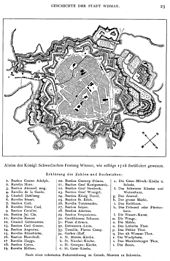
The fortress of Wismar around 1716

Wismar 1640
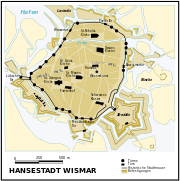
Wismar at the time of the Hanseatic League
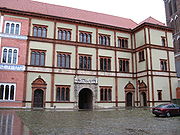
Prince's court in the Mecklenburg Johann Albrecht style, 16th century

Rebuilt St. George's Church, historical starting point of the new town of Wismar
Search within the encyclopedia


